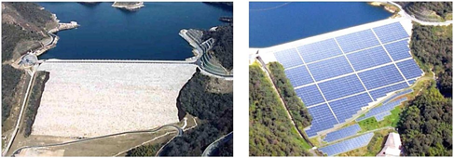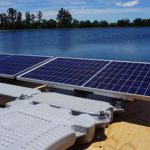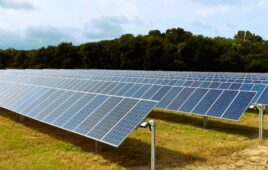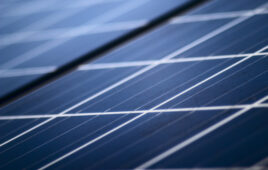
Floating PV at the Alto Rabagão pumped-storage reservoir, Portugal. Credit: Will Henley, International Hydropower Association and Energias de Portugal SA
By Emanuele Quaranta, subject matter expert, PreScouter
Hydropower and solar power plants were developed separately in the past. Recently, hydro and solar plants have started to merge into photovoltaic-hydropower hybrid plants, where floating solar panels are installed on the water surface of hydropower reservoirs and/or on the dam surface. This represents a cost-effective strategy for allocating new PV plants without occupying natural lands, protecting dams from insulation and increasing hydropower generation by reducing evaporation losses.
Globally, hydropower represents the largest share of renewable electricity generation, with almost 1,200 GW of installed capacity, where 328 GW are run-of-the-river plants (e.g., hydropower plants without storage reservoirs, or with very small ones). Hydropower is a renewable energy source with benefits for flood control, water management, promotion of leisure activities and stabilization of the electric grid.
However, a major loss in hydropower plants is the evaporation of water from reservoirs because the evaporated water cannot be exploited by the turbine to generate energy. Meanwhile, PV plants have grown exponentially since 2010, with a total installed capacity worldwide of about 400 GW that is expected to grow in the next decades.
Some of the biggest challenges, though, are that solar projects require large areas, and the warming of panels reduces their efficiency.
Photovoltaic-hydropower hybrid plants
In photovoltaic-hydropower hybrid plants, PV panels are incorporated into the hydro plant mainly in two ways: installation of PV panels on the downstream face of the dam, an option only possible in certain plants where the face slope of the dam is below 40° (like in gravity and embankment dams), or floating PV panels on the water surface of the hydropower reservoir.
In hybrid systems, several benefits are achieved with respect to the independent operation of the solar and hydro plants. In general, hydro plants are easy to access and already grid-connected, thus the installation of PV panels requires less work and infrastructure.
In the former case (PV on dams) the benefits are the following:
- PV panels protect the dam surface from direct solar radiation that may negatively affect the stability of the dam itself, reducing thermal excursion of the dam surface and increasing dam durability
- PV panels are installed on an existing structure (the dam surface), reducing land use
- Energy generated by PV can be used for pumping in pumped-storage hydropower plants
- PV panels are mounted on an inclined area, minimizing the distance required between two panels with respect to an analogous installation on a flat area, thus increasing solar energy generation
In the case of floating solar panels on hydropower reservoirs, the benefits are the following:
- Land use is minimized
- The cooling effect provided by water below the panels increases panel efficiency
- The shading provided by PV panels on the water reduces algae growth and water evaporation, improving hydro energy generation and water quality
- The water surface provides areas free of shading objects along with higher sunlight reflection, improving PV generation

Floating PV at the Alto Rabagão pumped-storage reservoir, Portugal. Credit: Michaela Costes, Ciel & Terre USA
Floating panels can increase the capacity factor of a hydropower plant by 50% to 100%, where the capacity factor of the hydro plant is the ratio of total generated energy to the maximum energy than can be generated if the hydro plant would always work at its maximum installed power capacity. Floating panels can gain 7% to 14% more energy than a land installation due to the reduction of temperature.
However, floating PV has an important limit: It cannot resist strong wind gusts, necessitating a very large number of mooring points in order for it to remain intact. The solution devised by the company Upsolar Floating is based on a much more robust concept where rafts are built with polyethylene pipes and steel beams supported by 20 to 24 panels. They have been shown to resist damage by wind up to 140 km per hour.
Real cases and costs
Floating solar panels installed on a dam surface can be applied to several dams across the globe. For example, a recent study carried out by the European Commission’s Joint Research Center revealed that the application of such hybrid systems to 10 selected dams in South Africa can generate an annual electricity amount of 72 GWh from PV from an installed peak power of 42 MWp. An example of a real project can be found in Japan’s Kutani Dam, with an installed PV capacity of 4.99 MWp and a 20-year revenue of ~ $5.4 million.

PV‐powered dam transformation in Japan. Credit: Kougias, I., Bódis, K., Jäger‐Waldau, A., Monforti‐Ferrario, F., & Szabó, S. (2016). Exploiting existing dams for solar PV system installations. Progress in Photovoltaics: Research and Applications, 24(2), 229-239
An interesting example of floating PV is at the Alto Rabagão pumped-storage reservoir in Portugal, with an installed capacity of 220 solar kWp. One other example is the 200-kWp floating solar project in Suvereto, Italy.
Today, a floating solar project costs 10% more than a solar plant on the ground, but this higher cost is overcome by the increased efficiency. The final kWh cost is 20% lower than a ground-based project. The cost for large projects is about ~ $763 per kWp, all included (mooring, cable, inverters, electric cabinet), while the final kWh price is in the range of $33 to $54 per MWh, depending on the local radiation conditions.
Potential estimation and conclusion
By assuming coverage of 25% of the 265.7 thousand sq. km that represent all existing hydropower reservoir surfaces with floating PV, 4,400 GW could be generated (6,270 TWh) that can reach 5,700 GW (8,000 TWh) using all existing reservoirs, both for hydropower and for other purposes. Floating solar could prevent about 74 billion cubic meters of water evaporation, increasing water availability by 6.3% and hydropower generation by 142.5 TWh.
This application to water reservoirs worldwide has already been considered, for a total installed capacity of floating PV of 376 MW in China, 22.7 MW in Japan, 9.3 MW in the United Kingdom, 6 MW in South Korea, 4 MW in Australia, 0.77 MW in Italy and 0.67 MW in the United States. Other examples, but at a minor scale with respect to the previously mentioned countries, can be found in Spain, Portugal, France and India.
Due to the advantages of this type of combined hybrid plant, the potential and market opportunities are expected to grow in the future, especially the floating solution, thus reducing the combined (hydro + solar) GHG emissions per kWh produced, particularly in tropical regions.
Emanuele Quaranta is a Subject Matter Expert at PreScouter. He is currently the project officer (scientific research) at the Joint Research Center of the European Commission (Water Directorate), a scientific referee for international journals and international congresses, a scientific consultant for companies, and an advisor for FederIdroelettrica (Italian association of hydropower). Previously, Emanuele was a post Ph.D. researcher at Politecnico di Torino (Turin, Italy) in hydraulic engineering, hydropower (expert in water wheels), eco-hydraulics (focus on fish passages) and fluid mechanics (CFD simulations) and a hydropower expert for the European Commission in 2017. Learn more about hydropower innovations in Emanuele’s blog Hydropower Altervista.











How will the hydro-part in this hybrid PV-complex potentially help in storing the PV-energy? Storage capacity is important, too, and reductons in, for example, lithium-ion-battery usage, could be an important aspect to the floating PV-plants.
Interested to know, what are the corrosion protection measures taken for such floating PV panels and supporting structures.
Also, would like to know the maintainence cost of such panels as access and handling would be challenging compared to land based ones.